 Title: The James Webb Space Telescope (JWST), named after James Webb (bottom right), launched on 25 December 2021. The satellite travelled 1.5 million km to her destination at Lagrange Point 2. This infrared telescope will assist in the study of the universe, including the TRAPPIST-1 exoplanet system. NASA, 2022.
Title: The James Webb Space Telescope (JWST), named after James Webb (bottom right), launched on 25 December 2021. The satellite travelled 1.5 million km to her destination at Lagrange Point 2. This infrared telescope will assist in the study of the universe, including the TRAPPIST-1 exoplanet system. NASA, 2022.
Go to
Updates
01sep2022: First images of Exoplanet HIP 65426 b.12jul2022: First images from Webb.
16mar2022: Mirrors optically aligned.
24jan2022: JWST reached its destination.
05jan2022: Shield / Mirror deployment.
Background
The James Webb Space Telescope.Goals of the mission.
Challenges.
JWST launch on 25 December 2021.
Milestones after launch.
JWST events post-orbit-delivery.
Personalities at the Christmas launch.
History and development.
James E. Webb.
Distances in space.
Lagrange points.
Halo orbit.
Telescope's structure and optics.
UPDATES
First images of an Exoplanet by Webb. Published on 01 September 2022
 Close up of Exoplanet HIP 65426 b.
Close up of Exoplanet HIP 65426 b.NASA/JWST, 01 September 2022.
The first image of an exoplanet (planet outside our solar system) taken by the Webb Telescope.
Exoplanet HIP 65426 b was imaged using the coronagraph capability of two of Webb’s instruments, the Near-Infrared Camera (NIRCam) and Mid-Infrared Instrument (MIRI)
The following image shows the exoplanet HIP 65426 b in different bands of infrared light, as seen from the James Webb Space Telescope: purple shows the NIRCam instrument’s view at 3.00 microns, blue shows the NIRCam instrument’s view at 4.44 microns, yellow shows the MIRI instrument’s view at 11.4 microns, and red shows the MIRI instrument’s view at 15.5 microns. These images look different because of the ways that the different Webb instruments capture light. A set of masks within each instrument, called a coronagraph, blocks out the host star’s light so that the planet can be seen. The small white star in each image marks the location of the host star HIP 65426, which has been subtracted using the coronagraphs and image processing. The bar shapes in the NIRCam images are artifacts of the telescope’s optics, not objects in the scene (JWST, 01 Sep 2022).
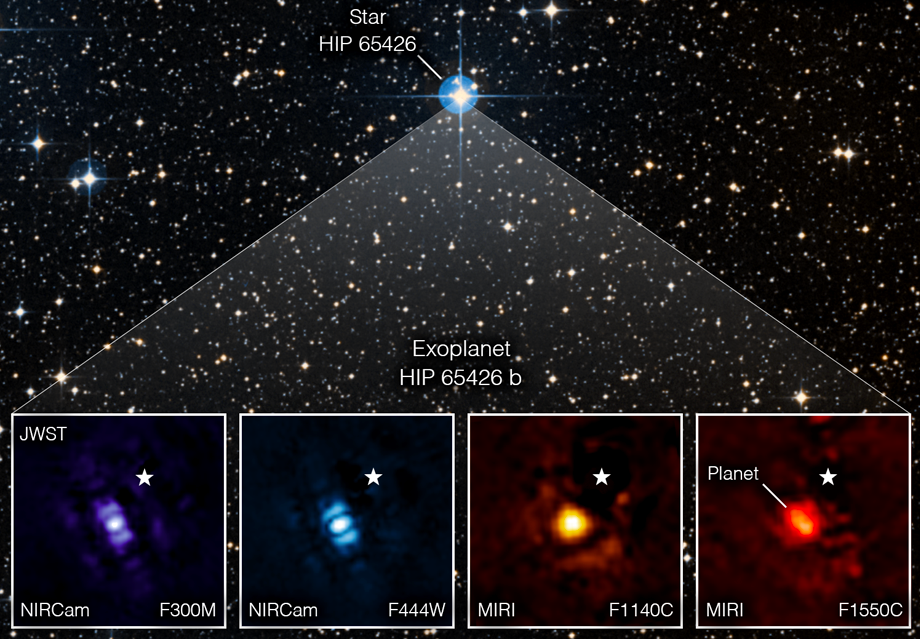 Exoplanet HIP 65426 b coronagraphy using, the Near-Infrared Camera (NIRCam) and Mid-Infrared Instrument (MIRI).
Exoplanet HIP 65426 b coronagraphy using, the Near-Infrared Camera (NIRCam) and Mid-Infrared Instrument (MIRI).NASA, ESA, CSA, Alyssa Pagan (STScI), 01 September 2022.
The Coronagraph is a telescope’s attachment that blocks the light of a star. The term derives from “corona”, which refers to the sun’s corona or crown during a total solar eclipse, when the Moon covers most of the Sun only allowing a crown of light to be visible. In that fleeting moment of darkness, stars can be seen around the sun, which are normally hidden by scattered sunlight and sky brightness.
 Sun’s corona, seen during a solar eclipse in 2017, where the moon covered the sun, revealing a crown of light around it and stars during the momentary dark sky. Nicolas Lefaudeux, Peter Ward, 2017.
Sun’s corona, seen during a solar eclipse in 2017, where the moon covered the sun, revealing a crown of light around it and stars during the momentary dark sky. Nicolas Lefaudeux, Peter Ward, 2017.
The same principle is applied to telescopes that use a relatively large mask to cover the Sun in a “Solar coronagraph” or a small mask to cover a star, in a “Stellar coronagraph”, allowing the observation of objects that are otherwise hidden by the star’s overpowering brightness.
 Dr Sasha Hinkley,
Dr Sasha Hinkley,University of Exeter, UK. Palereddot.org, 2016.
Exoplanet observations were carried out by an international team of researchers led by Dr Sasha Hinkley, Associate Professor of physics and astronomy at the University of Exeter, United Kingdom, as part of Webb’s international mission led by NASA in collaboration with its partners, ESA (European Space Agency) and CSA (Canadian Space Agency).
Exoplanet HIP 65426 b is a gas giant with 10 times the mass of Jupiter and is about 100 times farther from its host star than Earth is from the Sun, a distance that allows Webb to distinguish planet from star. Their difference in brightness makes it a challenge to observe as the planet is 10,000 times fainter than its star in the Near-Infrared and thousand times fainter in Mid-Infrared. It is believed that the planet was formed 15-20 million years ago.
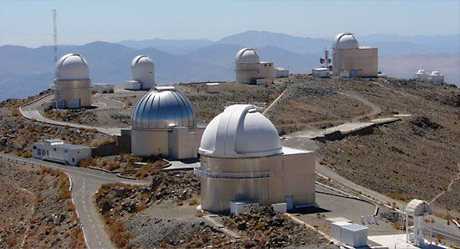 ESO’s Very Large Telescope (VLT) in Chile. ESO.org, 2013.
ESO’s Very Large Telescope (VLT) in Chile. ESO.org, 2013.This exoplanet was discovered in 2017 using the Spectro-Polarimetric High-Contrast Exoplanet REsearch (SPHERE) instrument on the European Southern Observatory’s Very Large Telescope (ESO - VLT) located at the summit of Cerro Paranal, Chile, at an altitude of 2,635m.
Considered the most advanced optical telescope to date, it consists of 4 Unit Telescopes, each with an 8.2m mirror, and 4 Auxiliary Telescopes that combined form a giant Interferometer called the “ESO Very Large Telescope Interferometer”.
The VLT is a predecessor of the European Extremely Large Telescope (E-ELT or ELT) on Cerro Armazones, also in northern Chile, which is under construction since 2017 and is expected to become functional in 2027.
 ESO’s Extremely Large Telescope (ELT): Artist impression (left) and actual construction site in 2022 (right). Wikipedia, 2022.
ESO’s Extremely Large Telescope (ELT): Artist impression (left) and actual construction site in 2022 (right). Wikipedia, 2022.
The successful acquisition of this images of an exoplanet demonstrate the capability of the Webb Telescope and mark the beginning of a new era of discovery. Prof Hinkley commented “This is a transformative moment, not only for Webb but also for astronomy in general”.
First images from the Webb Telescope published on 12 July 2022
The first public images of the universe as seen by the Webb Telescope show the faintest objects ever observed.
After a 12.5-hour exposure, the Webb’s Near-Infrared Camera (NIRCam) recorded galaxy cluster SMACS 0723 as it appeared 4.6 billion years ago. The infrared light generated by those stars and galaxies took that long to reach the telescope.
The area covered by this image is only a small portion of the universe surrounding us. This area would be equivalent to that covered by a grain of sand held at arm’s length.
The distortion that seems to stretch the galaxies circumferentially around the centre of SMACS 0723 is caused by the cluster’s gravitational density, which causes light to “bend” around its borders.
 Galaxy cluster SMACS 0723 shows thousands of galaxies and the faintest objects ever captured by the Webb Space Telescope. NASA/JWST, 12 July 2022.
Galaxy cluster SMACS 0723 shows thousands of galaxies and the faintest objects ever captured by the Webb Space Telescope. NASA/JWST, 12 July 2022.
NASA’s announcement of the first images from Webb
NASA released first images of the Webb Telescope on 12 July 2022 on a live video broadcast hosted by Dr Michelle Thaller, Assistant Director for Science Communication at NASA’s Goddard Space Flight Centre in Greenbelt, Maryland, USA.
Dr Thaller presented Dr John Mather, senior project scientist for the Webb Telescope and a Nobel laureate, who related how the project started back in 1995, shortly after the measurement of the Big Bang with the Cosmic Background Explorer satellite.
In the last 30 years, technological complexity increased with new scientific developments and the participation of 20,000 people from around the globe. The project was successfully coordinated by NASA’s JWST project manager Bill Oakes.
The first image released was a deep field view with a cluster of galaxies, known as SMACS 0723. This image was initially presented by Jane Rigby, Webb operations manager, and other officials at the White House.
 Dr Michelle Thaller hosted NASA’s announcement broadcast and presented Dr John Maher (right).
Dr Michelle Thaller hosted NASA’s announcement broadcast and presented Dr John Maher (right).On 11 July 2022, a delegation from NASA showed a preview of the first images from Webb to USA’s President Joe Biden at the White House. NASA/JWST, 12 July 2022.
Jane Rigby explained that since light travels at a constant speed, the objects that appear white on the image were likely to be shining that light at the time the Sun and the Earth were formed, around 9 billion years ago.
The cluster of stars distorts the view of what lies behind, galaxies that are farther away looked optically distorted and stretched. Among those are a few red faint ones, the most distant, which are the focus of the whole mission. The dimmest galaxies are seen as they looked more than 13 billion years ago, or about a billion years after the Big Bang, this is because light emanating from those galaxies took that long to reach the telescope.
An example of a faint and old galaxy is seen as a small red dot on the upper left quadrant of the full-scale close-up of SMACS 0723, next to two faint blue-dots.
 Full-scale close-up of Galaxy cluster SMACS 0723. Note the small faint red galaxy in the upper-left quadrant next to two blue dots. NASA/JWST, 12 July 2022.
Full-scale close-up of Galaxy cluster SMACS 0723. Note the small faint red galaxy in the upper-left quadrant next to two blue dots. NASA/JWST, 12 July 2022.
The Near Infrared Spectral analysis of this galaxy’s light suggest the presence of gases like Oxygen, Hydrogen and Neon.
 Spectral analysis of near infrared image of a faint galaxy located beyond SMACS 0723, 13.1 billion light-years away, shows signals corresponding to the presence of Oxygen, Hydrogen and Neon gases. NASA/JWST, 12 July 2022.
Spectral analysis of near infrared image of a faint galaxy located beyond SMACS 0723, 13.1 billion light-years away, shows signals corresponding to the presence of Oxygen, Hydrogen and Neon gases. NASA/JWST, 12 July 2022.
The Hubble Space Telescope, a predecessor of Webb, took a famous Deep Field image of a cluster of galaxies in 1995, requiring 340 exposures taken over 10 days. Webb took this deep field image in only 12 hours. A promising start that marks the beginning of a new era of astronomical discovery.
Exploring Exoplanets
Exploring Exoplanets has now become an important part of the Webb mission. Knicole Colon, an exoplanet scientist at NASA, explained the results of the near infrared analysis of an exoplanet called “Wasp-96b” located 1,000 light years away.
Planets do not generate light, they only reflect light from the nearest star, their atmosphere can be studied indirectly when they cross in front of their star, causing a partial eclipse. This technique called “Transit light curve (TLC)” measures relative brightness at progressive stages of this transit.
 Transit light curve measurements of relative brightness as exoplanet Wasp-96b moves in front of its star, recorded on 21 June 2022. NASA/JWST, 12 July 2022.
Transit light curve measurements of relative brightness as exoplanet Wasp-96b moves in front of its star, recorded on 21 June 2022. NASA/JWST, 12 July 2022.
Images captured at each stage can then be analysed further to detect chemical signatures. Wasp-96b showed wavelength signs of water vapour in its atmosphere, which supports the conclusion that this is a very hot giant exoplanet, about the size of Jupiter but with half its mass; It orbits closer to its star than Mercury does to our Sun, and travels at a very fast speed, completing an orbit in about 3.5 Earth days.
 The measurement of wavelength of light during transit light curve of exoplanet Wasp-96b shows signs of water vapour in its cloudy atmosphere.
The measurement of wavelength of light during transit light curve of exoplanet Wasp-96b shows signs of water vapour in its cloudy atmosphere.NASA/JWST, 12 July 2022.
 Alex Lockwood, Webb project scientist hosting from MOC in Baltimore. NASA/JWST, 12 July 2022.
Alex Lockwood, Webb project scientist hosting from MOC in Baltimore. NASA/JWST, 12 July 2022.Alex Lockwood, Webb project scientist co-hosted the broadcast from the Mission Operation Centre (MOC) in Baltimore, Maryland, from where the teams controlled and calibrated the instruments on Webb. the Science Operations programme works.
The Science Operations programme uses rigorous criteria to select the projects that will make the best use of the telescope. Scientific proposals come from across the world every year and only the best are picked. Klaus Pontoppidan, Webb project scientist, recalled that in 2016 a committee had to select only a handful from 70 proposed targets to decide what to look at initially with Webb, they were trying to showcase the maximum capability of the four science instruments onboard Webb.
Once the images arrived, they were processed and analysed by Joe Depasquale, Senior science visuals developer and Alyssa Patan, Science visuals developer, who translated invisible infrared light data into visible images and provided colour with filters to create a sense of separation of features, highlighting important elements.
 The image processing team looking at the first images from Webb. Visual developers Alyssa Patan and Joe Depasquale stand on the left.
The image processing team looking at the first images from Webb. Visual developers Alyssa Patan and Joe Depasquale stand on the left.At front, Klaus Pontoppidan, Webb project scientist at the Mission Operation Centre, Baltimore. NASA/JWST, 12 July 2022.
 Karl Gordon, Web instrument scientist
Karl Gordon, Web instrument scientistat MOC in Baltimore.
NASA/JWST, 12 July 2022.
Karl Gordon, Web instrument scientist presented the image of the Southern Ring, a planetary nebula formed by a dying star, which has expelled parts of its mass in successive waves that form concentric rings of gas and dust around the star. The Near Infrared camara (NIRcam) recorded these clouds of newly formed Hydrogen molecules as a foamy appearance more evident when colourised in orange. The blue haze in the middle corresponds to ionised gas heated by the remaining hot core of the star.
The Mid Infrared image (MID) on the right, shows molecular hydrocarbon forming on the surface of dust grains colourised in blue. The hot ionised gas is colourised red, and in the centre, Webb revealed for the first time a binary star, one red with dust around it and one blue, which were thought to exist in theory but were never seen.
 Southern Ring nebula as seen by the NIRcam (left) and MIRcam (right). NASA/JWST, 12 July 2022.
Southern Ring nebula as seen by the NIRcam (left) and MIRcam (right). NASA/JWST, 12 July 2022.
Detail of the upper left region of the Southern Ring nebula showing concentric waves of material and radiating shadows of light passing through the clouds.
 Detail of the upper left of the Southern Ring nebula (NIRcam). Notice concentric clouds of material and radiating shadows near the galaxies on the left.
Detail of the upper left of the Southern Ring nebula (NIRcam). Notice concentric clouds of material and radiating shadows near the galaxies on the left.NASA/JWST, 12 July 2022.
Even more detail on this closeup showing galaxies in different orientations at different depths.
 Close up of the left zone of the above image of the Southern Ring nebula showing galaxies seen on their side and from above at different depths (NIRcam).
Close up of the left zone of the above image of the Southern Ring nebula showing galaxies seen on their side and from above at different depths (NIRcam).NASA/JWST, 12 July 2022.
 Katy Haswell, host for ESA, Germany.
Katy Haswell, host for ESA, Germany.NASA/JWST, 12 July 2022.
Katy Haswell was the host of the broadcast from the Satellite Flight Control Centre of the European Space Agency (ESA) in Darmstadt, Germany.
The third image was presented by Giovanna Giardino, Webb’s Near Infrared Specialist (NIRSpec) and Mark McCaughrean, senior advisor for science and exploration, both from ESA. The image depicts a cluster of five galaxies known as Stephan's Quintet; each galaxy contains a million to hundred billion stars, located 40 million light-years away.
The group of galaxies, located at approximately 300 million light-years away, are kept together by gravity. Two of those galaxies seem to be merging and the gas heated up by this collision is what forms new stars. The Mid-infrared version of this quintet, revealed an active black-hole pulling-in gases that heat-up and generate light up to 40 billion times brighter than our Sun. Data collected by the telescope allows for the analysis of each wavelength providing clues about the chemical composition of those gases.
 Stephan's Quintet, a group of galaxies as seen by the NIRcam, contains a black hole revealed by heated gas. NASA/JWST, 12 July 2022.
Stephan's Quintet, a group of galaxies as seen by the NIRcam, contains a black hole revealed by heated gas. NASA/JWST, 12 July 2022.
The last image was presented by Amber Straughn, Webb deputy project scientist in the communications team.
 Amber Straughn, Webb deputy project scientist presents the Carina nebula. NASA/JWST, 12 July 2022.
Amber Straughn, Webb deputy project scientist presents the Carina nebula. NASA/JWST, 12 July 2022.
The Carina nebula, located 7600 light-years away, is still within the Milky Way, our galaxy. This is a star forming region that was imaged before by the Hubble Telescope, only this time the Webb Telescope produced a much higher resolution, revealing hundreds of stars that were never seen.
Young hot stars can be seen at the top of the scene, they radiate stellar wind that pushes away the clouds of gas and dust coloured in orange.
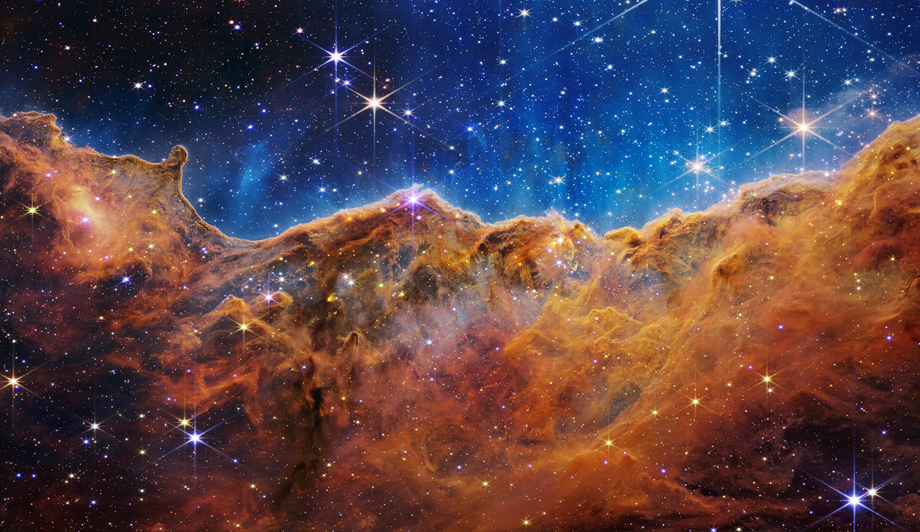 Carina nebula. The new high-resolution image taken by Webb shows hundreds of never seen stars. NASA/JWST, 12 July 2022.
Carina nebula. The new high-resolution image taken by Webb shows hundreds of never seen stars. NASA/JWST, 12 July 2022.
A moderate close-up of the Carina nebula shows the amazing detail in the new images with faint stars appearing beyond the gas nebula.
 Close-up of Carina nebula showing hundreds of faint stars beyond the clouds of gas and dust. NASA/JWST, 12 July 2022.
Close-up of Carina nebula showing hundreds of faint stars beyond the clouds of gas and dust. NASA/JWST, 12 July 2022.
Images of the same area taken by the Hubble Telescope in 2009 only showed the largest and brightest features of Carina.
 Hubble Telescope’s image of the Carina nebula from 2009 only show the main features. NASA, 30 July 2009.
Hubble Telescope’s image of the Carina nebula from 2009 only show the main features. NASA, 30 July 2009.
New image from August 2022
A new image released by NASA on 02 August 2022 shows the Cartwheel Galaxy, located 500 million light-years away in the Sculptor constellation. The unusual shape is the result of the collision of two galaxies that initiated an expansion wave, forming a “ring galaxy”. This galaxy is composed of a bright inner ring with star clusters near the hot-gaseous centre and an active outer ring with supernovas and stars in formation following interaction with gas. It is estimated that the expansion took about 440 million years. The NIRCam revealed more stars and the MIRI showed regions with hydrocarbons and silicate dust.
 The Cartwheel Galaxy (right) shows an inner ring of stars and an expanding outer ring with supernovae and star formation. Two smaller spiral galaxies on the left. NASA/JWST, 02 August 2022.
The Cartwheel Galaxy (right) shows an inner ring of stars and an expanding outer ring with supernovae and star formation. Two smaller spiral galaxies on the left. NASA/JWST, 02 August 2022.
Those first images are a testament to the advanced instruments on board Webb and the excellence of the scientific and engineering teams on the ground.
All the groups involved on the James Webb Telescope project received compliments for their success from Thomas Zurbuchen, NASA associate administrator for science and Webb senior project scientist, and John Mather, senior project scientist.
 Thomas Zurbuchen and John Mather compliment the Webb team for their success. NASA/JWST, 12 July 2022.
Thomas Zurbuchen and John Mather compliment the Webb team for their success. NASA/JWST, 12 July 2022.
Nasa Administrator, Bill Nelson quoted Carl Sagan, the famous astronomer and communicator,
“Somewhere, something incredible is waiting to be known”
This is only the beginning of a mission to explore the universe.
 Bill Nelson, NASA administrator quoted Carl Sagan:
Bill Nelson, NASA administrator quoted Carl Sagan:“ Somewhere, something incredible is waiting to be known”.
NASA/JWST, 12 July 2022.
Watch the video of the announcement from 12 July 2022 (56min):
Telescope’s mirrors optically aligned on 16 March 2022
Following a long journey and multiple tests and adjustments, the scientific team of the James Webb Telescope announced that they achieved full mirror alignment.
JWST Wavefront Sensing and Controls Scientist Scott Acton, stated that this alignment provides the highest optical performance and image resolution ever achieved for an instrument in space.
The telescope has performed better than the mathematical models said it should and after various levels of corrections, all the optical aberrations were eliminated.
To align he mirrors, the telescope used its primary imaging instrument called Pupil Imaging Lens (PIL) which forms an image of the 18 segments of the primary mirror onto the Near Infrared Camera (NIRCam) focal plane arrays (FPA). The first image was taken on 11 February 2022.
Refinement of the image continued with fine phasing, which created a blurred image to look for errors and find corrections, which were completed on 16 March 2022.
 Primary mirror first picture 11 Feb 2022. Mirror alignment by image stacking and fine phasing. Successful optical alignment on 16 March 2022. NASA/JWST.
Primary mirror first picture 11 Feb 2022. Mirror alignment by image stacking and fine phasing. Successful optical alignment on 16 March 2022. NASA/JWST.
Optical alignment will be checked in the other instruments and testing will continue until the entire telescope is optimised.
Watch the video of the announcement from 16 March 2022 (3min 43sec):
Webb Space Telescope reached its destination on 24 Jan 2022
The James Webb Space Telescope (JWST) reached its destination 1.5 million kilometres from Earth and with a final 5-minute burn, assumed its Halo Orbit at Lagrange Point 2. The arrival was announced on a live stream, presented by Tahira Allen, from NASA’s communications team, and included comments by the following guests:
Dr Amber Straughn, Webb Deputy Project Scientist for Communications at NASA Goddard, described the procedures needed to deploy the elements of the telescope and travel to its destination, a process that took nearly a month.
Scarlene Hernandez, Webb Flight Systems Engineer at the Space Telescope Science Institute, who reviewed the verification sequence performed by the control team, which included trajectory and temperature to ensure optimal conditions to start the instruments.
The next 6 months will be spent in calibration and testing of the mirrors to achieve perfect focus and verification of status of the instruments.
By the summer of 2022 the observatory will begin to acquire and send images of the universe and those will be processed by scientists who expect the first results by the end of the year.
Watch the video of the live stream broadcast on 24 January 2022 (54min):
Shield and mirror deployments – 05 January 2022
The deployment of the secondary mirror took place on 05 January 2022, a week and a half after launch, while the telescope was in orbit around the Earth. The live broadcast was presented by Dr Michelle Thaller, NASA Office of Communications.
The spacecraft was monitored and controlled by the Mission Operations Centre at the Space Telescope Science Institute, located on the Johns Hopkins University Homewood Campus in Baltimore, Maryland, USA. The team monitored the telescope indirectly using a visualisation tool that consisted of a 3D model of the telescope animated in synchronicity with telemetry feedback data, replicating the movements of the Webb Telescope almost in real time.
At the event, Deputy Commissioning Manager of JWST, Julie van Campen, related that after testing the motors, the Secondary Mirror Support Structure (SMSS) was unfolded in 11 minutes and locked into place. The secondary mirror’s final position is 7.3 metres (m) away from the primary mirror (see below).
Watch the video of the live stream broadcast on 05 January 2022 (1hr 27min):
BACKGROUND
The Webb Space Telescope
The James Webb Space Telescope is an astronomical observatory developed as a satellite in a collaborative effort of the National Aeronautics and Space Administration (NASA), the Canadian Space Agency (CSA) and the European Space Agency (ESA). The overall cost was US $10 billion and is expected to arrive to its destination in late January 2022.
Goal of the mission
The goal of the mission is to station the Webb Telescope at 1,5 million km from Earth, in a zone known as Lagrange Point 2, where the gravitational pull from the Earth and the Sun are minimal and small objects can remain in a relatively stable position in space with small adjustments (see below).
Once the telescope reaches its destination in 29 days (24 Jan 2022), cooling will begin and in 6 months all instruments will be checked and calibrated, and the mirrors aligned.
 Webb observatory (model). Compare the Visible light (left) to the Infrared image (right) of the Helix Nebula in the background, taken by the Hubble Telescope in 2014. NASA, 2022.
Webb observatory (model). Compare the Visible light (left) to the Infrared image (right) of the Helix Nebula in the background, taken by the Hubble Telescope in 2014. NASA, 2022.
As a space-based astronomical observatory, JWST will study four major themes:
- First light and reionization of the universe: This is the study of light that emerged from the first sources that followed the Dark Ages, which in turn followed the Big Bang. Those sources were million solar masses of stars radiating light when the first stars and galaxies formed, which is now moving away from us and therefore red-shifted into the near infrared (NIR). To detect such dim light the telescope will need longer than 100-hour exposures.
- Assembly of galaxies: JWST will investigate the processes that determine galaxy properties using a combination of imaging and spectroscopy to study of how galaxies assemble through a process of the hierarchical merging of dark matter concentrations, where small objects formed first, and were drawn together to form larger ones.
- Birth of stars and protoplanetary systems: JWST will study the specific problems of how protostellar clouds collapse, how environment affects star formation, the initial mass function at substellar masses, how protoplanetary systems form, and the life cycles of gas and dust. This will help understand how stars are formed from clouds of gas and dust, why most stars form in groups, or how planetary systems form.
- Formation of planetary systems and origins of life: JWST will study young, self-luminous planets, and planets around late-type stars. It will study the atmosphere of exoplanets, looking for chemical signatures of precursors of life.
Challenges
In addition to the technical challenges in creating the most sophisticated image capturing and processing instrument, the JWST project had to overcome unprecedented obstacles during its development.
In early 2011, a series of tornados cut the electric power to the George C. Marshall Space Flight Centre in Alabama for almost a week and production of the mirrors had to continue using diesel generators.
A snowstorm took place while testing the Integrated Science Instrument Module (ISIM) at the Goddard Space Flight Centre.
In 2017, Hurricane Harvey passing through Huston, Texas for four days causing catastrophic flooding and property damage while the telescope was undergoing cryogenic testing at NASA’s Johnson Space Centre, where they suffered water leaks through the ceiling, short supply of food, and team members having to be rescued by boat.
And if that was not enough, in 2020, a global COVID-19 pandemic put even more pressure on the teams, but they persevered and successfully completed the project by the end of 2021.
 European Spaceport (Centre Spatial Guyanais) located in Kourou, French Guiana. ESA, 2022.
European Spaceport (Centre Spatial Guyanais) located in Kourou, French Guiana. ESA, 2022.
JWST launch on 25 December 2021
The telescope was launched on 25 December 2021 on board an Ariane-5 VA256 Rocket from the Guiana or European Spaceport (Centre Spatial Guyanais) located in Kourou, French Guiana, on the north-east coast of South America, neighbouring the Caribbean Sea. The European Spaceport is managed by the National Centre for Space Studies or Centre national d'études spatiales (CNES), the French Government Space Agency, which became operational in 1968.
Mission activities were monitored from three Webb control centres: The Jupiter Mission Control Centre at the European Spaceport in Korou, French Guiana; the Launch Control Centre, 2 km from the Spaceport; and the Telescope Control Centre or Mission Operations Centre (MOC), based at the Space Telescope Science Institute in Baltimore, Maryland, USA, which took control of the remaining of the mission after launch.
Thirty minutes before launch the Ariane-5 rocket was fuelled with 175 tons of propellant, 150 tons of liquid oxygen, and 25 tons of liquid hydrogen. The upper stage was loaded with 15 tons of propellant for the 16-minute burn to gain speed to the final orbit.
 Ariane 5 rocket ready for launch at the French Guiana European Spaceport. NASA/ESA, 25 December 2021.
Ariane 5 rocket ready for launch at the French Guiana European Spaceport. NASA/ESA, 25 December 2021.
The final authorisation from weather control was given at -10 min, and at -7 min they topped up the tanks and initiated the synchronised sequence.
At launch, the Vulcan-2 engine of the Main stage ignited and 7 seconds later it was followed by the 9 Merlin engines on the Solid boosters, which provided 90% of the thrust for lift-off.
 Firing of Main Stage’s Vulcan 2 engine. NASA/ESA, 2021.
Firing of Main Stage’s Vulcan 2 engine. NASA/ESA, 2021.
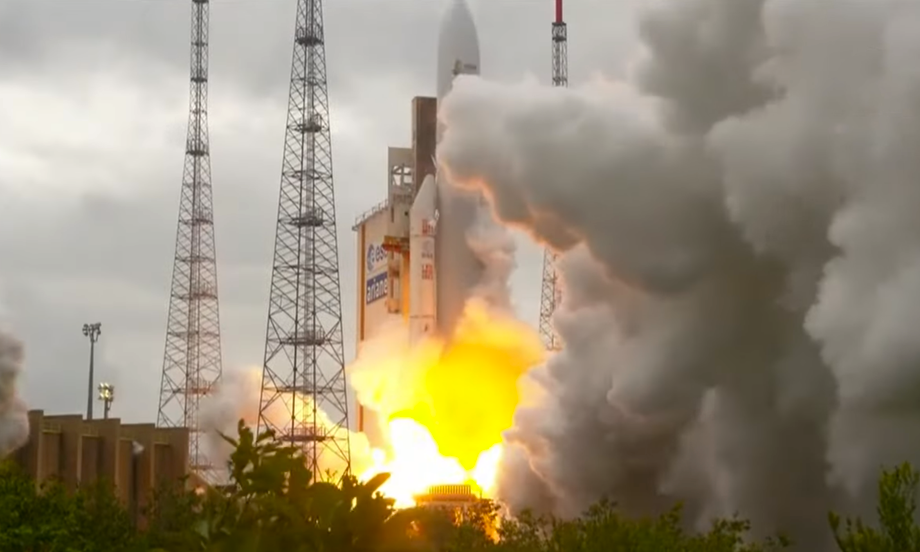 Lift-off of Ariane 5 carrying JWST to orbit. NASA/ESA, 25 December 2021.
Lift-off of Ariane 5 carrying JWST to orbit. NASA/ESA, 25 December 2021.
 Lift-off of Ariane 5 carrying JWST to orbit. NASA/ESA, 25 December 2021.
Lift-off of Ariane 5 carrying JWST to orbit. NASA/ESA, 25 December 2021.
Milestones after launch
- At 1 min 5 sec, the Ariane-5 reached Maximum Dynamic Pressure (Max-Q) at which the rocket was exposed to the maximum aerodynamic forces at a speed of 0.6 km/s.
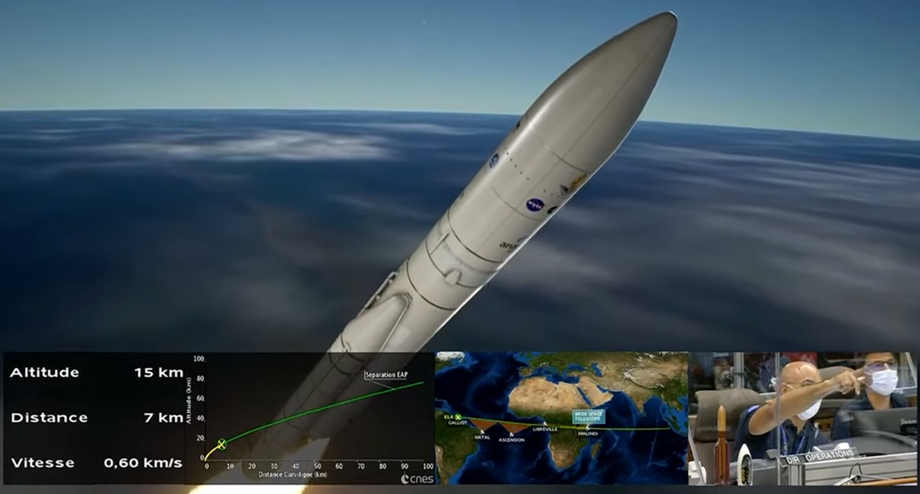 1min 12sec: Animation of Ariane 5 rocket ascending at a speed of 0.6 km/s and an altitude of 15km, 7km away from the Spaceport. NASA/ESA, 25 December 2021.
1min 12sec: Animation of Ariane 5 rocket ascending at a speed of 0.6 km/s and an altitude of 15km, 7km away from the Spaceport. NASA/ESA, 25 December 2021.
- At 2 min 21 sec, the Solid rocket boosters shut down and separated.
 2min 22sec: Animation of Ariane 5 rocket ascending at a speed of 1.8 km/s and an altitude of 50km, 50km away from the Spaceport. Solid rocket boosters separate, Main stage engine took over. NASA/ESA, 25 December 2021.
2min 22sec: Animation of Ariane 5 rocket ascending at a speed of 1.8 km/s and an altitude of 50km, 50km away from the Spaceport. Solid rocket boosters separate, Main stage engine took over. NASA/ESA, 25 December 2021.
- At 3 min 26 sec, the Fairing or cupula was jettisoned to expose the Webb telescope.
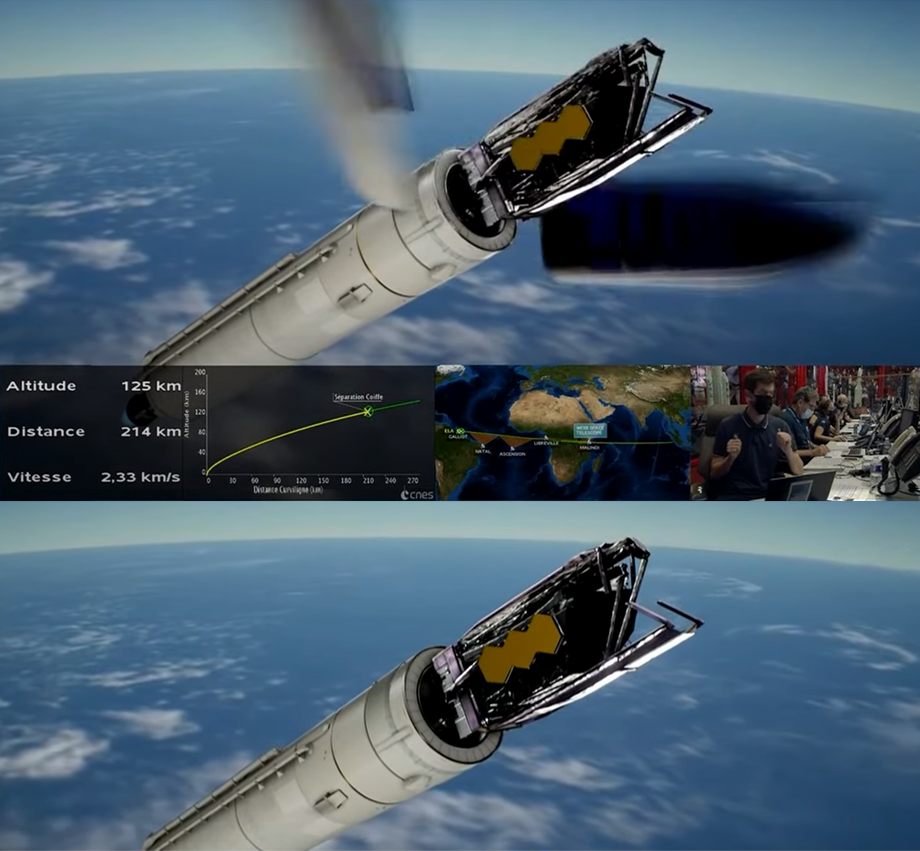 3min 25sec: Animation of Ariane 5 rocket ascending at a speed of 2.3km/s and an altitude of 125km, 214km away from the Spaceport. Fairing jettisoned to expose Webb to space. NASA/ESA, 25 December 2021.
3min 25sec: Animation of Ariane 5 rocket ascending at a speed of 2.3km/s and an altitude of 125km, 214km away from the Spaceport. Fairing jettisoned to expose Webb to space. NASA/ESA, 25 December 2021.
- At 8 min 47 sec, the Main engine cut-off and separated from the upper stage at and altitude of 220 km, travelling at 7 km/s.
 8min & 10min: Animation of Ariane 5 at a speed of 7km/s and an altitude of 228km, 1,508km away from the Spaceport. Main stage separated. Upper stage and JWST speeding to insert into orbit. NASA/ESA, 25 December 2021.
8min & 10min: Animation of Ariane 5 at a speed of 7km/s and an altitude of 228km, 1,508km away from the Spaceport. Main stage separated. Upper stage and JWST speeding to insert into orbit. NASA/ESA, 25 December 2021.
- The upper stage engine burned for 16-minutes.
- At 24 min 51 sec, the upper stage engine cut off followed by a coast phase of 2 min 30 seconds to stabilise the spacecraft.
- At 27 min 6 sec, the observatory separated, marking the end of the Ariane-5 portion of the mission with the delivery of its cargo into orbit, and the beginning of the Webb Space Telescope mission.
The JWST was delivered to orbit at an altitude of 1,400 km, 840 km higher than the Hubble Space Telescope (orbit altitude 600 km, speed 7.6 km/s, period 97min) and more than 970 km higher than the International Space Station (ISS) (orbit altitude 380 km, speed 7.7 km/s, period 92min).
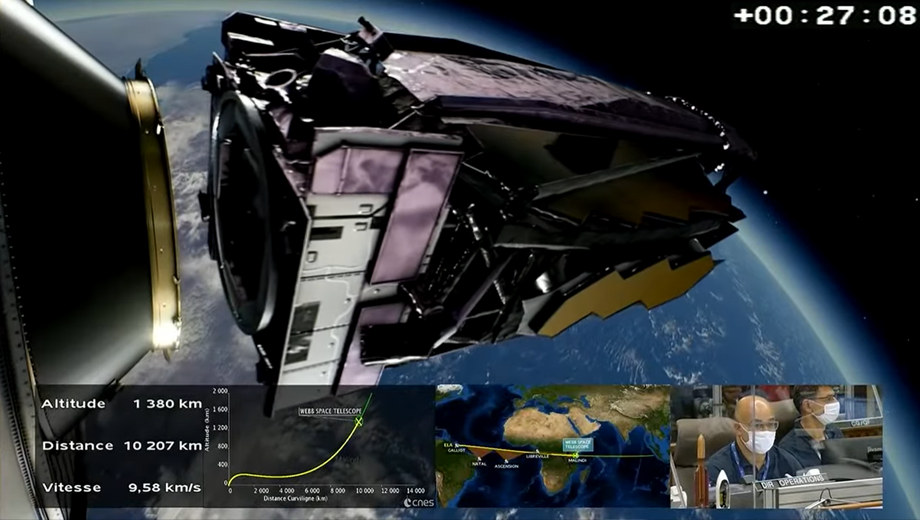 27min: Animation of JWST separation from Ariane 5 upper stage at a speed of 9.5km/s and an altitude of 1,380km, 10,207km away from the Spaceport. JWST successfully delivered into orbit. NASA/ESA, 25 December 2021.
27min: Animation of JWST separation from Ariane 5 upper stage at a speed of 9.5km/s and an altitude of 1,380km, 10,207km away from the Spaceport. JWST successfully delivered into orbit. NASA/ESA, 25 December 2021.
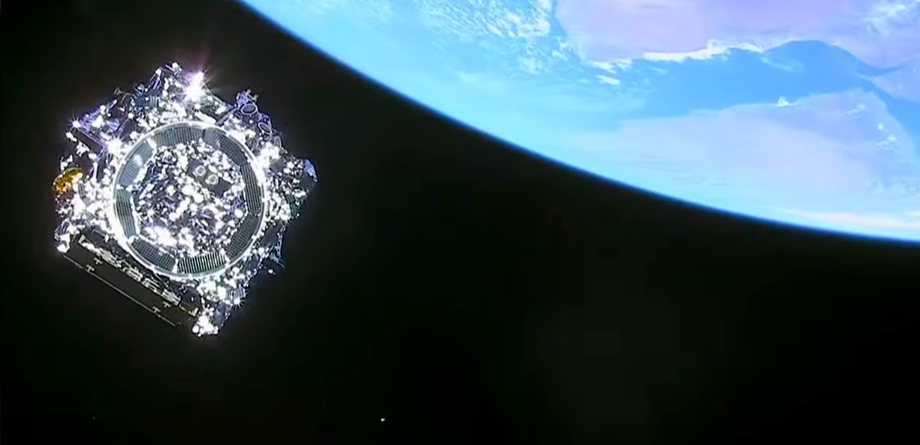 28min: Photograph of JWST in orbit as it separates from the upper stage, both moving at a speed of 9.5km/s and an altitude of 1,380km. NASA/ESA, 25 December 2021.
28min: Photograph of JWST in orbit as it separates from the upper stage, both moving at a speed of 9.5km/s and an altitude of 1,380km. NASA/ESA, 25 December 2021.
Shortly after the control room confirmed that the Webb telescope’s solar arrays were generating the power, the MOC took over command for the remaining of the mission.
Once it began its journey into space, Webb travelled at a speed of 33,800 km/h to its final destination 1,5 million km from Earth, where it adopted a halo orbit around Sun-Earth Lagrange Point 2. Webb travelled so fast that it passed the Moon’s orbit in 1.5 days, half the time it took the Apollo missions in the 1960s.
Events post-orbit delivery
The separation of JWST from Ariane 5’s upper stage (see above), was followed by the next milestones:
- 31 min: Solar array deployment: To generate own power and go off of battery power.
- 2 hr: High-gain Gimbaled Antenna Assembly (GAA) deployment: Antenna points at Earth for ground communications.
- 12 hr: Mid-course correction burn (MCC1a): Most important burn to fine-tune its direct trajectory towards LP2.
 Webb telescope: Solar array and Gimbaled Antenna Assembly (GAA) deployments, followed by Mid-course correction burn (MCC1a). NASA/ESA, 25 December 2021.
Webb telescope: Solar array and Gimbaled Antenna Assembly (GAA) deployments, followed by Mid-course correction burn (MCC1a). NASA/ESA, 25 December 2021.
- 2 days: Mid-Course Correction burn (MCC1b): Short burn to adjust trajectory.
- 3 days: Sunshield pallet deployment: The Utilised Pallet Structure (UPS) housing the sunshield extends to final position; first the Forward, followed by the Aft sections.
- 4 days: Deployable Tower Assembly (DTA): The central tower is raised 1.22m to operational height, creating more distance between the telescope and the shield.
- 5 days: Momentum flap deployment: Unfolded at the end of the Aft UPS to help offset some of the solar pressure that impinges on the sunshield and minimise fuel use.
- 5 days: Sunshield membrane covers release: Roll up after protecting the shield during transport.
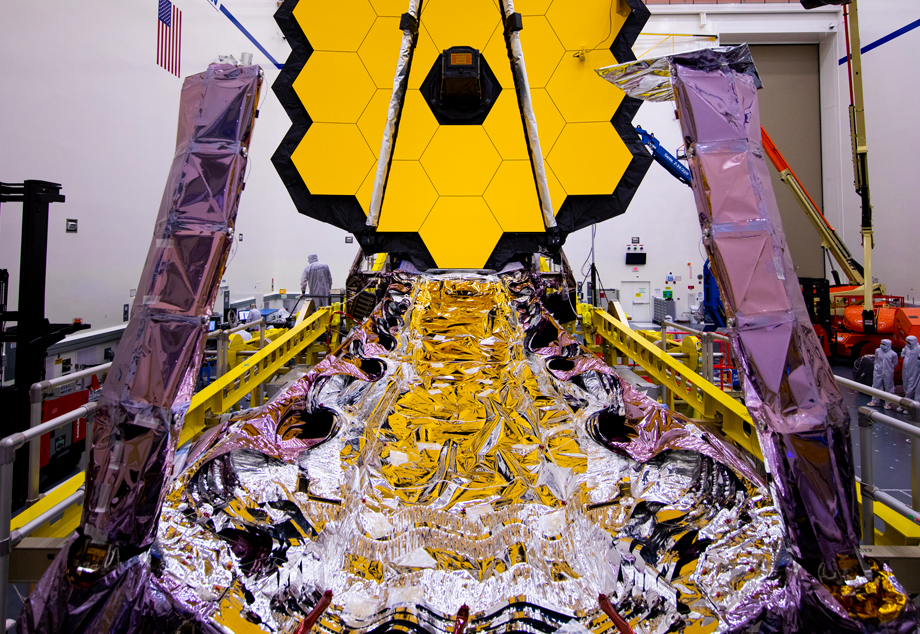 Webb telescope: Folded sunshield and membrane covers during assembly. NASA, November 2021.
Webb telescope: Folded sunshield and membrane covers during assembly. NASA, November 2021.
- 6 days: Sunshield mid-boom deployment (+J2, -J2): The Mid-Boom extended the left side (Port), followed by the right side (Starboard) of the sunshield.
- 7-9 days: Sunshield membrane layers tensioning: All 5 layers tensioned in 2 days, completing the sunshield deployment.
- 10 days: Secondary mirror support structure: The structure unfolded and secured the secondary mirror, placing it at 7.3 m from the primary mirror. This convex mirror is as adjustable as all the other concave mirror panels.
- 11 days: Aft Deploy Instrument Radiator (ADIR): The box behind the primary mirror is the Integrated Science Instrument Module (ISIM) and contains the JWST instruments. Those instruments need additional cooling, provided by this radiator panel that unfolded into working position.
- 12 days: Primary mirror wing deployment – Port side: The Left side mirror swinged into place.
- 13 days: Primary mirror wing deployment – Starboard side: The Right side mirror swinged into place. Each wing of the primary mirror holds 3 sections. Transitioning from the stowed or launch position, the 18 sections of the primary mirror were set in place in operational position.
- 18-28 days: Individual mirror segment movements: Beginning of testing actuators to slowly align the 18 segments of the primary mirror, and the secondary mirror.
- 11 days: Aft Deploy Instrument Radiator (ADIR): The box behind the primary mirror is the Integrated Science Instrument Module (ISIM) and contains the JWST instruments. Those instruments need additional cooling, provided by this radiator panel that unfolded into working position.
- 29 days: Mid-Course Correction Burn (MCC2): After travelling 1,609,344 km away from Earth, there was a engine burn to inject the Webb telescope into a Halo orbit around Sun-Earth Legrange Point 2.
Animation of the full telescope deployment sequence, theoretically without issues (nominal)
Webb’s destination: A “halo orbit” at Sun-Earth Lagrange Point 2 (L2)
Personalities at the launch
The live broadcast was introduced by Dr Michelle Thaller, Assistant Director for Science Communication at NASA’s Goddard Space Flight Centre in Greenbelt, Maryland, USA. The event was hosted at the European Spaceport in Korou by Katy Haswell, an acclaimed television presenter, actress and voiceover artist with expertise in science and technology.
 Katy Haswell, presenter of the launch event based in Korou. NASA/ESA, 25 December 2021.
Katy Haswell, presenter of the launch event based in Korou. NASA/ESA, 25 December 2021.
Launch commentary was provided from the Jupiter launch control centre by Luce Fabreguettes, head of infrastructure and value chain for ESA and Rob Navias, known as “the voice of NASA” from the public affairs office.
 ESA’s Luce Fabreguettes and NASA’s Rob Navias provided commentary during launch from the Jupiter control centre in Korou. NASA/ESA, 25 December 2021.
ESA’s Luce Fabreguettes and NASA’s Rob Navias provided commentary during launch from the Jupiter control centre in Korou. NASA/ESA, 25 December 2021.
Prelude to launch - About the mission
While the Spaceport personnel were busy completing preparations for launch, the presenters interviewed the following representatives of the scientific and technical teams:
 Macarena Garcia Marin, ESA Scientist, and a graphic showing range of wavelengths regarded as Near-Infrared and Mid-Infrared.
Macarena Garcia Marin, ESA Scientist, and a graphic showing range of wavelengths regarded as Near-Infrared and Mid-Infrared.NASA/ESA, 25 December 2021.
ESA Instrument Calibration Scientist for Webb’s MIRI instrument, Macarena Garcia Marin, explained that the telescope will attempt to detect infrared light that remaining in galaxies after the Big Bang, which took place millions of years ago. Due to the expansion of the universe this light has passed and although the visible range is no longer found, infrared light may remain.
Infrared detection allows instrument to “see through clouds” of dust and other cold particles in space, which would normally block visible light. This will enhance the study of old and new galaxies. MIRI stands for Mid-InfraRed Instrument, the main contribution of the European Space Agency to the partnership with NASA’s Jet Propulsion Laboratory (JPL) and Goddard Space Flight Center (GSFC). The instrument uses the mid-infrared wavelength range from 5 to 28.3 microns, which is closer to red and cooler.
To detect this range of light, the sensor needs to be colder than the cold of space, requiring active cooling produced by a cryogenic cooler that brings the instrument to below 5 degrees Kelvin (-268 degrees Celsius).
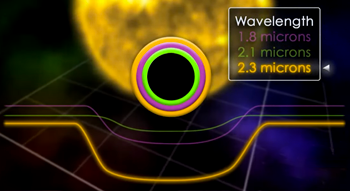 Coronography studies the light wavelengths surrounding a bright object obscured with a mask, to find a chemical signature.
Coronography studies the light wavelengths surrounding a bright object obscured with a mask, to find a chemical signature.NASA/ESA, 25 December 2021.
MIRI has a Coronography mode consisting of masks to cover bright objects and allow the study of light from the periphery or “corona”. The wavelength combination found in this area provides a signature that makes it possible to deduce its chemical composition.
 Knicole Colon, NASA Deputy Project Scientist, and a graphic showing the contrast in temperatures on the Hot or Sunny side and the Cold or Dark side of the Sunshield, where the telescope works.
Knicole Colon, NASA Deputy Project Scientist, and a graphic showing the contrast in temperatures on the Hot or Sunny side and the Cold or Dark side of the Sunshield, where the telescope works.NASA/ESA, 25 December 2021.
NASA Deputy Project Scientist for Exoplanet Science, Knicole Colon, described that one of the goals of the infrared telescope is to study the atmosphere and other characteristics of exoplanets (see below), and moving objects like meteors and particles outgassing from them.
For this task, the telescope needs to operate at less than 50 degrees Kelvin (-233 degrees Celsius). If a telescope of this type were used on Earth, it would pick up the heat of atmospheric particles, which would obscure its real targets.
 Keith Parrish, JWST manager involved in the construction of the Sunshield, seen in the background during development.
Keith Parrish, JWST manager involved in the construction of the Sunshield, seen in the background during development.NASA/ESA, 25 December 2021.
JWST Observatory Commissioning Manager, Keith Parrish, showed a sample of Kapton, the material used for the shield. Five layers of this material outstretched to the size of a tennis court. The layers are separated with enough space to let heat escape creating a 500-degree temperature drop. This material is coated with silicon to decrease the temperature and provide durability, and a metal for electrical conductivity to avoid the build-up of electrical charges. The shield has a purple hue that faces the sun. It is S-folded for transport and unfolded in space.
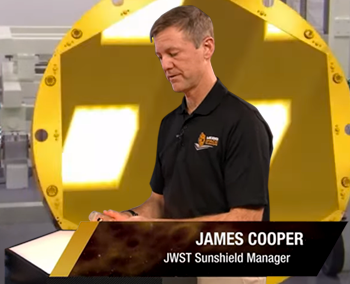 James Cooper, JWST manager showed a sample of the mirror made of Beryllium, seen in the background.
James Cooper, JWST manager showed a sample of the mirror made of Beryllium, seen in the background.NASA/ESA, 25 December 2021.
JWST Sunshield Manager, James Cooper, showed a sample of the 178 non-explosive actuators; 107 of which are in the membrane-release mechanism, all of which must work for a successful deployment. He also showed a sample of one of the 18 mirrors on the telescope, The original ones are machined out of a single piece of Beryllium to the exact curvature and once in place, each segment can be focused to act as a single curved mirror. The gold coating provides the reflective property required in the infrared. The primary mirror operates at about -240 degrees Celsius.
CEO of Arianespace, Stephane Israel, described the attributes of the Ariane-5 rocket that delivered the telescope into orbit. The company has a history of 111 successful launches of Ariane-5 rockets since their first launch on Christmas eve 1979. The development of this rocket is the result of a collaborative effort of 12 European countries.
ESA Acting Head of Ariane 5 Adaptation and Future Missions, Daniel de Chambure, explained the modifications required to safely accommodate the satellite in preparation for launch. This was the largest payload they ever had to carry, taking all available space in the load compartment at the top of the rocket. The combined weight of the rocket at launch was 770 tonnes. They had to ensure depressurisation was smooth and that the orientation of the telescope was always away from the sun to prevent damage to sensitive instruments.
ESA specialist, Raphael Chevrier, explained the advantages of the ESA launch site located in the jungle of the French Guiana, north of Brazil, one of the best-preserved natural habitats in the world. The ESA Spaceport is on the coast and launched vehicles travel over the sea without affecting inhabited areas; there are no earthquakes, hurricanes or tropical storms; being so close to the equator, the rotational speed of the surface of the planet is at its highest, at 1,600 km/h, therefore vehicles launched already have this initial speed in the correct direction and need less fuel to continue to orbit.
The Ariane-5 rocket is composed of two solid boosters located at both sides of the central column or main cryogenic stage. The main engine is located at the bottom of the cryogenic stage and each booster has its own engine.
 Daniel de Chambure, head of Ariane 5 adaptation and Raphael Chevrier, ESA specialist, explained the process of placing the Webb Telescope into Ariane 5 rocket’s fairing or tip of the upper stage. NASA/ESA, 25 December 2021.
Daniel de Chambure, head of Ariane 5 adaptation and Raphael Chevrier, ESA specialist, explained the process of placing the Webb Telescope into Ariane 5 rocket’s fairing or tip of the upper stage. NASA/ESA, 25 December 2021.
NASA Webb Telescope Programme Director, Greg Robinson, acknowledged that more than 10,000 people were involved in the project, coming from 29 States in the USA, and 14 countries across the globe, as well as many industries and suppliers that took part indirectly.
Remarks after the delivery of Webb into space
 Dr John Mather, Webb Senior Project Scientist. NASA, 2021.
Dr John Mather, Webb Senior Project Scientist. NASA, 2021.
NASA Goddard’s Webb Senior Project Scientist, Dr John Mather, winner of the Nobel Prize for measuring the Big Bang using an observatory built at NASA’s Goddard centre, was working on the Space Telescope mission since its inception in 1995, even before the construction of its predecessor, the Hubble Telescope.
Dr Mather explained that gravity is the only force of nature that always pulls, and although it is very weak, it spans a long range and dictates the formation of stars and galaxies from dust and gases expelled by the Big Bang.
Gravitational energy can be converted into kinetic energy and heat, making large objects become self-heating, e.g. gasses like Hydrogen and Helium under the influence of gravity, get compressed to the point of having nuclear reactions and turn into other chemical elements.
Webb will not only observe exoplanets, it will also allow the study of our solar system, e.g. Jupiter’s satellite Europa and its icy surface, and Saturn’s satellite, Titan, and its solid ice and liquid hydrocarbons; the observations will precede future missions that will visit those satellites.
NASA Administrator, Bill Nelson, congratulated the teams and thanked the agencies for their participation in such a massive project that took more than 20 years of research and preparation.
NASA Associate Administrator for the Science Mission Directorate, Dr Thomas Zarbuchen, recognised the importance of the project for the scientific community of present and future.
Arianespace CEO, Stephane Israel, thanked the agencies that entrusted his company with the construction and development of the Ariane-5 heavy rocket that delivered the telescope to Earth orbit.
 Bill Nelson, Thomas Zurbuchen from NASA, and Stephen Israel from Arianespace, comment following the delivery of JWST into space. NASA/ESA, 25 December 2021.
Bill Nelson, Thomas Zurbuchen from NASA, and Stephen Israel from Arianespace, comment following the delivery of JWST into space. NASA/ESA, 25 December 2021.
ESA Director General, Josef Aschbacher, praised the contribution of European countries that in partnership, advanced the development of the telescope, assembled the rocket and managed the launch.
CNES-president, Philippe Baptiste, thanked all those involved in the development of this two-decade project and the 500 people involved in the launch of the vehicle, the space agencies and the French Armed Forces based in Guiana, who facilitated launch preparations and operations.
CSA President, Lisa Campbell, highlighted the importance of the collaboration between countries around the world and congratulated the Canadian teams involved in the project.
 Josef Aschbacher and Philippe Baptiste from ESA, and Lisa Campbell from CSA, comment following the delivery of JWST into space. NASA/ESA, 25 December 2021.
Josef Aschbacher and Philippe Baptiste from ESA, and Lisa Campbell from CSA, comment following the delivery of JWST into space. NASA/ESA, 25 December 2021.
History and development
Research on the space telescope began in 1986. It was proposed as a project named “The Next Generation Space Telescope (NGST)” in September 1989 at a workshop held at the Space Telescope Science Institute in Baltimore, Maryland, USA. By the late 1990s NASA had a preliminary plan and in September 2002 the name of the project was changed to “James Webb Space Telescope (JWST)” (see below).
Construction began in 2004 with the build of the mirrors, which were meticulously polished and coated in a thin layer of gold. Other components were built in space centres in USA, Europe and Canada. In the early 2010s, all the parts were sent to NASA Goddard Space Flight Centre in Greenbelt, Maryland, USA for final assembly.
After the integration of the four science instruments, the telescope underwent testing to determine its resistance to launch and the harsh environment of space: Vibration and acoustic testing at Goddard, and a 100-day cryogenic testing at the largest thermo-vacuum chamber in the world, built to test the Apollo capsule in 1960s, located at Johnson Space Centre in Huston, Texas.
The sun shield was developed and added at Northrop Grumman Space Park in Redondo Beach, California and tested again for folding and deployment. In September 2021 the completed telescope travelled 9,300 km in 16 days through land and sea traversing the Pacific coast, crossing the Panama Canal and the Caribbean Sea to finally arrive at the port of Korou, French Guiana on 12 October 2021.
At Guiana Spaceport, its last location on Earth, the telescope was unpacked, mounted atop an Ariane-5 rocket and launched on Christmas day 2021.
History of the Webb Telescope in video clips
Watch a summary of the assembly, packing and transport of the Webb telescope from Northrop Grumman in Redondo Beach, to Seal Beach, California and to Korou, French Guiana, then launched from the Guiana Spaceport (1min 30sec per video except part 6, with duration of 2min 13sec):
James E. Webb
 James E. Webb, second NASA administrator, 1961-1968.
James E. Webb, second NASA administrator, 1961-1968.NASA/JWST, 2021.
The Webb telescope was named after James E. Webb (1906–1992), NASA's second administrator, who served between 1961 and 1968.
Webb led the Apollo exploration programme, which paved the way to landing the first humans on the Moon (after his retirement). He also initiated a vigorous space science programme that was responsible for more than 75 launches.
President John F. Kennedy offered Webb the job, which he accepted despite having a background in business and law, but he was also a manager and was ideal for NASA, a complex organisation established in 1958.
Distances in space
To appreciate the enormous distances in space, think about the following facts:
- The distance between the Sun and the Earth is of about 150 million kilometres and is known as one Astronomical Unit (AU); it is used as a reference to measure distances between planets.
- In relation to the new position of the telescope, the Earth is 100 times closer to Lagrange 2 than it is to the Sun.
- The James Webb telescope is 2,631 times further away from the Earth than its predecessor, the Hubble space telescope.
 Distances from Sun to Earth, from Earth to the Hubble telescope, from Earth to the Moon and from Earth to Lagrange 2. NASA, 2021.
Distances from Sun to Earth, from Earth to the Hubble telescope, from Earth to the Moon and from Earth to Lagrange 2. NASA, 2021.
Lagrange Points
In 1772, Italian astronomer Joseph-Louis Lagrange described that in the spatial interaction between two large objects there are points where their gravitational attraction combines to produce an area of equilibrium or neutral gravitation.
His description was the solution to the “Three-body problem” raised by the stable configuration by which 3 bodies could orbit each other and stay in the same position. There are 5 solutions to this problem, therefore called 5 Lagrange Points. At Lagrange points, the gravitational pull of two large masses precisely equals the centripetal force required for a small object to move with them with minimal effort.
Although the first Lagrange point (L1) is between the gravitational zones of the Sun and the Earth, the second (L2) is on the opposite side of Earth from the Sun. A third point (L3) is on the opposite side of the Sun from Earth, while L4 lies ahead of the Earth on its orbit plane and L5 lies behind, in a position formed by an equilateral triangle between the two large masses (Sun and Earth).
 Lagrange points and areas of gravitational influence of two large masses depicted as force lines, which when tightly packed, represent a more intense gravitational force. The coloured triangles show the direction of gravitational pull. Satellites at Lagrange points tend to wander off. The scroll shows Lagrange’s birth name.
Lagrange points and areas of gravitational influence of two large masses depicted as force lines, which when tightly packed, represent a more intense gravitational force. The coloured triangles show the direction of gravitational pull. Satellites at Lagrange points tend to wander off. The scroll shows Lagrange’s birth name.NASA/Wikipedia, 2021.
Lagrange points are relative to the smaller mass (e.g. Earth), following it as it orbits around the larger mass (e.g. Sun), it therefore exists wherever two objects interact gravitationally.
 On this decorated vessel, Achilles kills Hector
On this decorated vessel, Achilles kills Hectorduring the siege of Troy. British Museum, 2021.
Due to this gravitational neutrality, Lagrange points tend to attract smaller objects known as Trojans, named after the three large asteroids, that orbit in the L4 and L5 points of Jupiter: Agamemnon, Achilles and Hector.
According to Homer, the ancient Greek Mythology author, Trojan champion Hector was slain by Achilles during King Agamemnon's siege of Troy.
There are 4 observatories in orbit at L1, an ideal point for solar observation:
- The Comprehensive Solar Wind Laboratory for Long-Term Solar Wind Measurements (WIND), launched in 1994.
- The Solar and Heliospheric Observatory Satellite (SOHO), launched in 1995.
- The Advanced Composition Explorer (ACE), launched in 1997.
- The Deep Space Climate Observatory (DSCOVR), launched in 2015.
L2, on the other hand, is relatively shielded from the sun by the shadow of the Earth and the Moon and is ideal for observation of the universe, and is the location of various satellites:
- The Wilkinson Microwave Anisotropy Probe (WMAP), originally known as the Microwave Anisotropy Probe (MAP and Explorer 80), was a NASA spacecraft operating from 2001 to 2010 which measured temperature differences across the sky in the cosmic microwave background (CMB).
- The Herschel Space Observatory (HSO), launched by ESA in 2009, as a predecessor of JWST, to study the far infrared wavelength range between 55 and 672 micrometres. The mission finished in 2013 when the telescope run out of coolant and was sent on a heliocentric orbit that will encounter Earth in several hundred years. The mission was a success that lead to many astronomic discoveries and the publication of more than 150 scientific papers.
- The Planck satellite, launched by ESA in 2012 to collect Cosmic Microwave information.
- The Gaia Space Observatory, launched by ESA in 2013 and expected to operate until 2022. Designed to measure positions, distances, motion, luminosity, temperature, gravity and elemental composition of stars (astrometry), to build a 3D space catalogue comprising of 1 billion astronomical objects.
- The James Webb Space Telescope (JWST) joined the above at L2 on 24th January 2022.
All satellites at Lagrange points 1 and 2 by 2022:
 Lagrange Point 1 and Point 2 satellites from 1995 to 2022. NASA, 2022.
Lagrange Point 1 and Point 2 satellites from 1995 to 2022. NASA, 2022.
Halo orbit
JWST assumed a primary orbit around the Sun, on the opposite side of Earth and the Moon. In addition, the telescope follows a Halo Orbit around Lagrange Point 2, a periodic circular path in a plane perpendicular to the line between the telescope, Earth and the Sun. This periodic orbit requires less propulsion corrections to be maintained than a less stable, quasi-periodic Lissajous orbit around the Lagrange Point.
From Earth’s perspective, Webb will essentially be at the same location in the midnight sky (1.5 km away), which facilitates communications using 3 large antennas located in Australia, Spain and California, which form part of the Deep Space Network (DSN). Uplink of commands and downlink of data takes place twice a day, under the control of the Space Telescope Science Institute in Baltimore.
 James Webb Space Telescope’s halo orbit at Lagrange Point 2, a location within the shadow of the Earth. NASA, 2021.
James Webb Space Telescope’s halo orbit at Lagrange Point 2, a location within the shadow of the Earth. NASA, 2021.
JWST optics and structure
The telescope
The JWST is a reflecting telescope that uses mirrors to focus light coming from the infinite into a focal plane, forming an image that corresponds point by point to the source. Mirrors have distinct advantages over glass in telescopes; they are light, cheap, have no chromatic aberration, but more difficult to align and produce other forms of distortion due to change in curvature. The complex optical design is based on mirrors with Aspherical surfaces to reduce distortion when focusing light. The Webb telescope has 3 curved mirrors and a flat mirror to steer the light and form an image on the photo-sensor.
Essential optics
Lenses and mirrors in a telescope change the direction of light to form images. In lens-based optical systems, light changes direction as it enters and exits a lens due to the angle at which it arrives or leaves in relation to the surface or media interface. This change is also influenced by the density of the material, e.g., glass, plastic. In the case of mirrors, the density is not important, and all the effect is based on the angle of incidence.
When light comes from a point located far away at an optically infinite distance, it is depicted as parallel rays of light arriving to a lens. Rays hitting the centre of a lens, or axis, do not change direction as this point is essentially flat.
In a lens with a curved surface light arriving in parallel encounter angles progressively steeper the farther away they are from the axis. Convex lenses have a curvature that makes those parallel rays aim at a single point of focus, where the image is projected point by point.
The gradual change in the surface angles give lenses a curved shape or convex curvature, as if they were a section of a sphere, hence the name “Spherical Lenses”. If they were created with a cast, this structure would have the opposite shape, a hollowed out concave shape that is also a part of a sphere. If that surface were reflective like a mirror, it would be a “Spherical Mirror”. Spherical lenses form images behind them, because light passes through them, while mirrors reflect light to form images in front of them.
 Example of a convex lens with a bulging surface, and its cast, with a concave surface, which would be the shape of a mirror of the same power.
Example of a convex lens with a bulging surface, and its cast, with a concave surface, which would be the shape of a mirror of the same power.Parallel rays of light change direction as they travel through a lens (refraction) to aim at a point of fucus.
In a mirror they bounce off (reflexion) the concave surface to aim at a point of focus in front of the mirror.
In practice, light passing through or reflecting off a spherical surface fails to coincide on a single point, inducing distortion that results in lack of sharpness of an image. To compensate for this error, the curvature of the periphery of the optic is changed and no longer resembles a sphere, therefore this shape is called Aspheric.
In physics, aspheric surfaces can be described by the Radius of curvature and the Conic Constant (K or Khapa), which in a Spherical lens would be 0, but on Aspherical conical lenses would be: other than 0, e.g., Parabola (K = -1), Hyperbola (K = < -1), Oblate ellipse (K > 1) or Ellipse (-1 < K < 0).
 Aspherical lenses have an irregular curvature to compensate for distortion and form sharper images than Spherical ones.
Aspherical lenses have an irregular curvature to compensate for distortion and form sharper images than Spherical ones.
In the case of the JWST, the optical system is composed of a set of aspherical mirrors, where the Primary mirror (M1) is composed of an array of movable panels that can be adjusted to improve the curvature to compensate for diffraction errors. Incoming light reflected from the primary mirror goes to the smaller secondary mirror (M2) located on a support that keeps it in front and in the middle of the system, this is a convex mirror that reflects light to a smaller tertiary concave mirror (M3), which in turn sends the light to a flat Steering mirror and finally to the light sensor or focusing surface.
In summary, light is concentrated and folded by mirrors to come to a focus point where an image is formed and then processed by instruments that translate this light stimulus into data sent to Earth for scientific analysis.
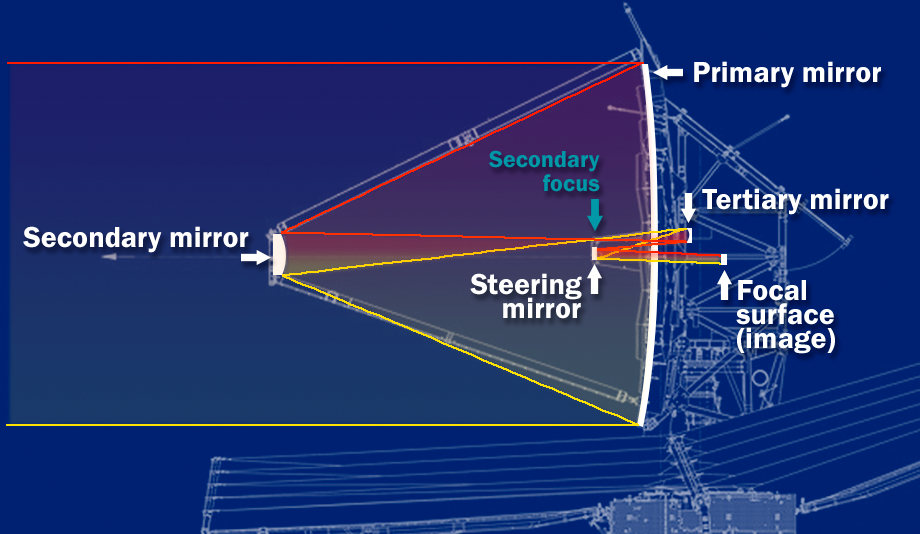 The JWST is a 3-mirror system with an additional steering mirror. The light path ends at the focal surface, where the final image is captured and processed.
The JWST is a 3-mirror system with an additional steering mirror. The light path ends at the focal surface, where the final image is captured and processed.NASA/JWST, 2022.
Path of light as it travels through the reflector telescope:
The telescope’s main component details.
| Mirror | Surface | Radius of curvature (metres) | Size or diameter (metres) | Conic consant (Khapa) |
|---|---|---|---|---|
| Primary | Concave | 15.88 | 6.6 | - 0.9967 |
| Secondary | Convex | 1.78 | 0.74 | - 1.6598 |
| Tertiary | Concave | 3.01 | 0.73 x 0.52 | - 0.6595 |
| Steering | Flat | n/a | 0.17 | n/a |
Optical components
 JWST’s primary mirror:18 panels with a diameter of 6.5 m.
JWST’s primary mirror:18 panels with a diameter of 6.5 m.NASA/JWST, 2021.
The Primary Mirror (PM) is concave and composed of eighteen 1.3m-wide hexagonal panels arranged in a honeycomb configuration with an overall diameter of 6.5m, covering an area of 24 square metres.
Built by Ball Aerospace & Technologies Corp., Boulder, Colorado, USA, each panel weighs 20 kg and is made of Beryllium coated in Gold, which has excellent reflectivity in the Infrared spectrum of light and is very stable over time. Each section has independent actuators to allow for calibration and focusing movements but add weight to a total of 40 kg per panel.
This large primary mirror collects light from the sky and bounces it off towards a smaller secondary mirror.
 JWST’s secondary mirror with a diameter of 0.74 m.
JWST’s secondary mirror with a diameter of 0.74 m.NASA/JWST, 2021.
The Secondary Mirror (SM) is convex, made of the same material and has a diameter of 0.74m, mounted on a large stand called the Secondary Mirror Support Structure (SMSS), which is deployed after launch to place the SM 7.3m in front of the PM and bounce light towards the Aft Optics Subsystem (AOS), at the centre of the PM.
 JWST’s aft optics subsystem: A conical structure at the centre of the primary mirror. Secondary mirror in its stowed position (top-left).
JWST’s aft optics subsystem: A conical structure at the centre of the primary mirror. Secondary mirror in its stowed position (top-left).NASA/JWST, 2021.
The AOS is a conical structure that holds the Tertiary Mirror (TM) a concave unit that corrects optical distortion before sending the light to the Fine Steering Mirror (FSM), which is flat and bounces light to the light sensor, located at the Focal Surface Plane.
Behind the primary mirror is the Thermal Management Subsystem (TMS), which is a box that contains various optical devices and instruments.
Building the mirrors
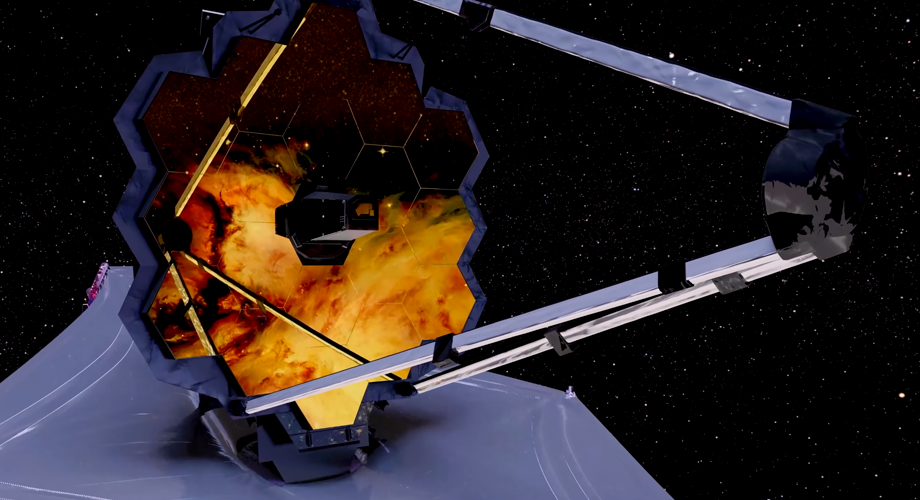 The Webb Space Telescope mirrors are the main components of the observatory. NASA/JWST, 2022.
The Webb Space Telescope mirrors are the main components of the observatory. NASA/JWST, 2022.
 Webb's primary mirror is 6.5 m-wide compared to Hubble’s 2.4 m single primary mirror. NASA/JWST, 2021.
Webb's primary mirror is 6.5 m-wide compared to Hubble’s 2.4 m single primary mirror. NASA/JWST, 2021.
One of the first challenges faced by the engineering team was to build a mirror 3 times larger than its 1990’s predecessor, the Hubble Space Telescope, which has a single 2.4 m mirror. The solution was to make a 6.5 m mirror out of 18 hexagonal concave panels. Each 1.3 m panel could be separated for launch and assembled robotically in space.
After design, production began in 2004 and completed in 2015, when they were sent for installation, which took an additional year. During this process the mirrors went through 11 different places in the USA to complete manufacturing.
To keep the mirrors light and strong, they were made of Beryllium (Be) and carefully polished to achieve a continuous curvature when acting together. To improve reflectivity in the infrared spectrum of light, they were coated with a 100-atom thick layer of gold and a superficial layer of silicon to give it strength and resistance to damage.
Following Webb’s arrival and acquisition of orbit at Lagrange-2, it took six months to align and calibrate the mirrors.
The following video shows this process as planned by the engineering and image acquisition teams on the ground.
MORE CONTENT COMING SOON
REFERENCES
» Carter J (2018) How One Photographer Captured ‘Earthshine’ During Last Year’s Solar Eclipse In Wyoming? Medium.com (23 August 2018) [Online article]. Available at medium.com. Accessed: 01 September 2022.
» Cornish N (2021) What is a Lagrange Point? NASA (23 June 2020) [Online article]. Available at solarsystem.nasa.gov. Accessed: 21 December 2021.
» Corr S (2021) Irish scientists' key role in developing ground-breaking telescope that will be launched into space on Christmas Day. MSN News, 22 December 2021 [Online article]. Available at msn.com. Accessed: 22 December 2021.
» CSG (2021) Centre Spatial Guyanais [Online article]. Available at centrespatialguyanais.cnes.fr. Accessed: 21 December 2021.
» DIAS (2021) The Dublin Institute for Advanced Studies (DIAS) [Online article]. Available at dias.ie. Accessed: 22 December 2021.
» ESA (2021) MIRI factsheet. European Space Agency [Online article]. Available at esa.int. Accessed: 19 January 2022
» ESA (2021) Planck. European Space Agency [Online article]. Available at sci.esa.int. Accessed: 21 December 2021.
» ESO (2022) Very Large Telescope: The world's most advanced visible-light astronomical observatory. European Southern Observatory (ESO). [Online article]. Available at eso.org. Accessed: 01 September 2022.
» Excellenttalent (2021) Katy Haswell [Online article]. Available at excellenttalent.com. Accessed: 25 December 2021.
» Freemars (2021) Orbital speed [Online article]. Available at freemars.org. Accessed: 20 January 2022.
» Gutro R (2022) The amazing anatomy of the James Webb Space Telescope Mirrors. NASA. [Online article]. Available at nasa.gov. Accessed: 25 January 2022.
» Hinkley S (2016) Directly imaging exoplanets. Pale Red Dot. [Online article]. Available at palereddot.org. Accessed: 01 September 2022.
» HST (2015) Behind the Webb: Working Stiff (Episode 29). Hubble Space Telescope (29 October 2015). [Online video]. Available at youtube.com. Accessed: 20 Dec. 2021.
» JWST (2022) First Images from the James Webb Space Telescope. JWST (12 July 2022). [Online article]. Available at nasa.gov. Accessed: 13 July 2022.
» JWST (2022) Image of Exoplanet HIP 65426 b in Near and Mid Infrared. JWST (01 September 2022). [Online article]. Available at webbtelescope.org. Accessed: 01 September 2022.
» JWST (2022) James Webb Space Telescope laser-focused sight (30 October 2017). [Online video]. Available at youtube.com. Accessed: 02 August 2022.
» JWST (2022) Webb Captures Stellar Gymnastics in The Cartwheel Galaxy. JWST (02 August 2022). [Online article]. Available at nasa.gov. Accessed: 04 August 2022.
» Landau E (2018) 10 Things: All About TRAPPIST-1. NASA, Solar System Exploration. 20 February 2018. [Online article]. Available at solarsystem.nasa.gov. Accessed: 02 January 2022.
» Lightsey P (2012) James Webb Space Telescope: large deployable cryogenic telescope in space," Optical Engineering 51(1), 011003 (3 February 2012). https://doi.org/10.1117/1.OE.51.1.011003. [Online article]. Available at spiedigitallibrary.org. Accessed: 25 January 2022.
» McManus B (2021) The insane engineering of James Webb Telescope. Real Engineering (18 Dec. 2021) [Online video]. Available at youtube.com. Accessed: 20 Dec. 2021.
» NASA (2020) James Webb Space Telescope. NASA's Goddard Space Flight Center. [Online article]. Available at nasa.gov. Accessed: 01 January 2022.
» NASA (2020) Webb global contributor map. NASA's Goddard Space Flight Center, 06 August 2020. [Online article]. Available at svs.gsfc.nasa.gov. Accessed: 01 January 2022.
» NASA (2021) Fine Guidance Sensor / Near Infrared Imager and Slitless Spectrograph (FGS/NIRISS). James Webb Space Telescope, Instruments. [Online article]. Available at jwst.nasa.gov. Accessed: 24 January 2022.
» NASA (2021) James Webb Space Telescope Launch (25 Dec. 2021) [Online video]. Available at youtube.com. Accessed: 25 Dec. 2021.
» NASA (2021) Largest batch of Earth-size, habitable zone planets. Exoplanet exploration. [Online article]. Available at youtube.com. Accessed: 02 January 2022.
» NASA (2021) Mid-Infrared Instrument (MIRI). James Webb Space Telescope, Instruments. [Online article]. Available at jwst.nasa.gov. Accessed: 24 January 2022.
» NASA (2021) Near Infrared Camera (NIRCam). James Webb Space Telescope, Instruments. [Online article]. Available at jwst.nasa.gov. Accessed: 02 January 2022.
» NASA (2021) Near Infrared Spectrograph (NIRSPEC). James Webb Space Telescope, Instruments. [Online article]. Available at jwst.nasa.gov. Accessed: 02 January 2022.
» NASA (2021) Stephan’s Quintet. [Online article]. Available at science.nasa.gov. Accessed: 30 July 2022.
» NASA (2021) The James Webb Space Telescope Instruments. NASA. [Online article]. Available at nasa.gov. Accessed: 24 January 2022.
» NASA (2021) The James Webb Space Telescope. Animation (12 Apr. 2021) [Online video]. Available at youtube.com. Accessed: 26 January 2022.
» NASA (2021) What is a Lagrange Point? NASA, Solar System Exploration. [Online article]. Available at solarsystem.nasa.gov. Accessed: 02 January 2022.
» NASA (2022) Advanced Composition Explorer (ACE). [Online article]. Available at science.nasa.gov. Accessed: 09 February 2022.
» NASA (2022) Comprehensive Solar Wind Laboratory for Long-Term Solar Wind Measurements (WIND). [Online article]. Available at wind.nasa.gov. Accessed: 09 February 2022.
» NASA (2022) First Full-Colour Images and Data from the James Webb Space Telescope. Press release from 12 July 2022. [Online article]. Available at images.nasa.gov. Accessed: 13 July 2022.
» NASA (2022) James Webb Space Telescope: Deployment Explorer. NASA's Goddard Space Flight Center. [Online article]. Available at jwst.nasa.gov. Accessed: 07 February 2022.
» NASA (2022) James Webb Space Telescope: The Mirrors. NASA's Goddard Space Flight Center. [Online article]. Available at jwst.nasa.gov. Accessed: 08 February 2022.
» NASA (2022) James Webb Space Telescope: The Sunshield. NASA's Goddard Space Flight Center. [Online article]. Available at jwst.nasa.gov. Accessed: 07 February 2022.
» NASA (2022) James Webb Space Telescope: Webb Orbit. NASA's Goddard Space Flight Center. [Online article]. Available at jwst.nasa.gov. Accessed: 09 February 2022.
» NASA (2022) Solar and Heliospheric Observatory. [Online article]. Available at sohowww.nascom.nasa.gov. Accessed: 09 February 2022.
» Nayturr (2020) Types of telescopes. Nayturr.com. [Online article]. Available at nayturr.com. Accessed: 24 January 2022.
» NOAA (2022) DSCOVR: Deep Space Climate Observatory. National Environmental Satellite Data and Information Service (NOAA). [Online article]. Available at nesdis.noaa.gov. Accessed: 09 February 2022.
» Planet Science (2017) Big Bang explained by Prof Lawrence Kraus and Prof Michio Kaku [Online video]. Available at youtube.com. Accessed: 31 May 2022.
» Pultarova T (2022) James Webb Space Telescope nails secondary mirror deployment. Space.com. [Online article]. Available at space.com. Accessed: 24 January 2022.
» Sandlin D (2021) How does the James Webb Space Telescope work? Smarter Every Day 262, 01 October 2021 [Online video]. Available at youtube.com. Accessed: 31 May 2021.
» Sandlin D (2022) Why are there holes in the James Webb Telescope sunshield? Smarter Every Day 270, 01 March 2022 [Online video]. Available at youtube.com. Accessed: 01 August 2022.
» Science Time (2022) Why did the Big Bang happen? Explained by Prof Brian Cox [Online video]. Available at youtube.com. Accessed: 31 May 2022.
» Simon J (2018) These award-winning photos capture incredible details of the sun and the Moon. Quartz, 25 October 2018. [Online article]. Available at qz.com. Accessed: 01 September 2022.
» Smethurst R (2020) If the Universe is expanding, where is the centre? Explained by Dr Becky [Online video]. Available at youtube.com. Accessed: 08 June 2022.
» University of Exeter (2022) First exoplanet image from James Webb Space Telescope revealed. 01 September 2022. [Online article]. Available at exeter.ac.uk. Accessed: 01 September 2022.
» Webb Telescope (2021) Webb Space Telescope. [Online article]. Available at webbtelescope.org. Accessed: 28 December 2021.
» Wikipedia (2022) Coronagraph [Online article]. Available at wikipedia.org. Accessed: 01 September 2022.
» Wikipedia (2022) Extremely Large Telescope [Online article]. Available at wikipedia.org. Accessed: 01 September 2022.
» Wikipedia (2021) James Webb Space Telescope [Online article]. Available at wikipedia.org. Accessed: 20 December 2021.
» Wikipedia (2021) Lagrange Point (23 June 2020) [Online article]. Available at wikipedia.org. Accessed: 21 December 2021.
» Wikipedia (2021) Michelle Thaller [Online article]. Available at wikipedia.org. Accessed: 25 December 2021.
» Wikipedia (2022) Gaia (spacecraft) [Online article]. Available at wikipedia.org. Accessed: 26 January 2022.
» Wikipedia (2022) Herschel Space Observatory [Online article]. Available at wikipedia.org. Accessed: 26 January 2022.
» Wikipedia (2022) Lissajous orbit [Online article]. Available at wikipedia.org. Accessed: 26 January 2022.
» Wikipedia (2022) Three-mirror anastigmat. [Online article]. Available at wikipedia.org. Accessed: 24 January 2022.
MORE CONTENT COMING SOON